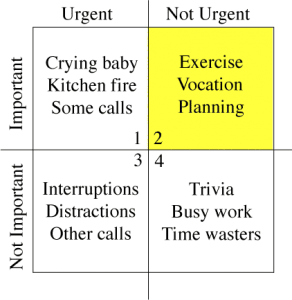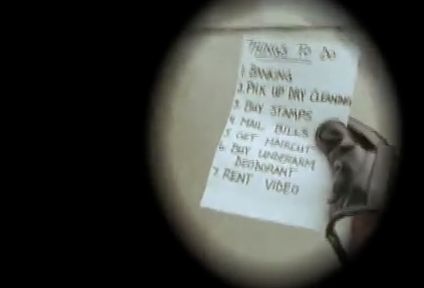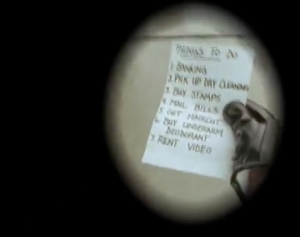Are you constantly scrambling to get stuff done at the last minute? Maybe the problem isn’t what you do or not do, but how you prioritize it. The scrawled list of things “to do” may work well if you only have a few simple tasks to accomplish, as one of the best Kids in the Hall sketches demonstrates. I used to put things on my to-do list like “drink coffee” and “drink more coffee.” This made me feel productive, but it didn’t get my important tasks done.
When you have to do important, complex tasks, and figure out how to best implement the Pareto Principle, it is best to implement a system. Steven Covey’s time management quadrant is an easy way to prioritize things. You don’t even actually need to fill in all the quadrants. For the purposes of this blog, we’re considering a to do list that only contains academic things.
Quadrant I is important, urgent items. Your house is on fire? Quick, write it into the quadrant (actually, don’t) and get out. Gotta pee? Quadrant I. That 14 page paper you have been putting off for 2 months and that’s now due tomorrow? That’s important and urgent, now. Quadrant II is important, but not urgent. That’s where you put stuff like calculus homework due next week, a paper due in a month, and so on.
Quadrant III is where you have to make some choices: these are not important, but urgent things are ones you can’t get out of. They might be homework assignments for classes you hate, or conversations with that roommate who never shuts up. It might be scheduling an appointment with your advisor because you know you have to do it this term. They might include eating before you pass out.
Quadrant IV is for not important, not urgent stuff. Just thinking about what might go here can help you focus your energies. Tragically, reading hilarious Wikipedia articles is not going to get your important, urgent tasks done. Neither will re-watching every episode of your favorite childhood cartoon on YouTube. Someday these things may ec=-
The trick with this system is doing things before they become important and urgent, because most things eventually become urgent if you do not attend to them. Not important and not urgent – those might be things you want to do, like Facebook, or things that otherwise do not improve your life. I used to put “Return library books” on there because even though it was not important (at least before they were overdue), and not even really urgent, it made me feel productive. Don’t do that.
I used this system for years and it helped me become a top student in high school, college, and graduate school. Here are my tips:
- Break down big tasks into smaller tasks. “Dissertation” was important, but putting it on my to do list was, obviously, useless. “Add suggested sources to dissertation prospectus” was not, and it was both important and urgent.
- Appointments are important and urgent, because flaking out is shady, and having an appointment in your day affects how much of your time is left to do other things.
- Put categories of unimportant, not-urgent stuff in Quadrant IV. Don’t write in specific timewasters, but keep your eye on it and ask yourself if you are getting distracted or if what you are doing is contributing to the big picture.
- Consider each item in Quadrant II to be a ticking time bomb. If you don’t deal with it, after a while it will become urgent. And urgent, important tasks are no fun.
- Only you get to decide what is important. Sometimes, school gets so intense you have to make tough decisions, and this might mean that a worksheet for art history isn’t as important as, say, a business exam. This might mean that you need to outsource or ask for help.
Have you let an important task become urgent? Are you trying to delegate your work flow so that you can work smarter, not harder? Try letting an Unemployed Professor tackle the task so you can focus on other important things.

